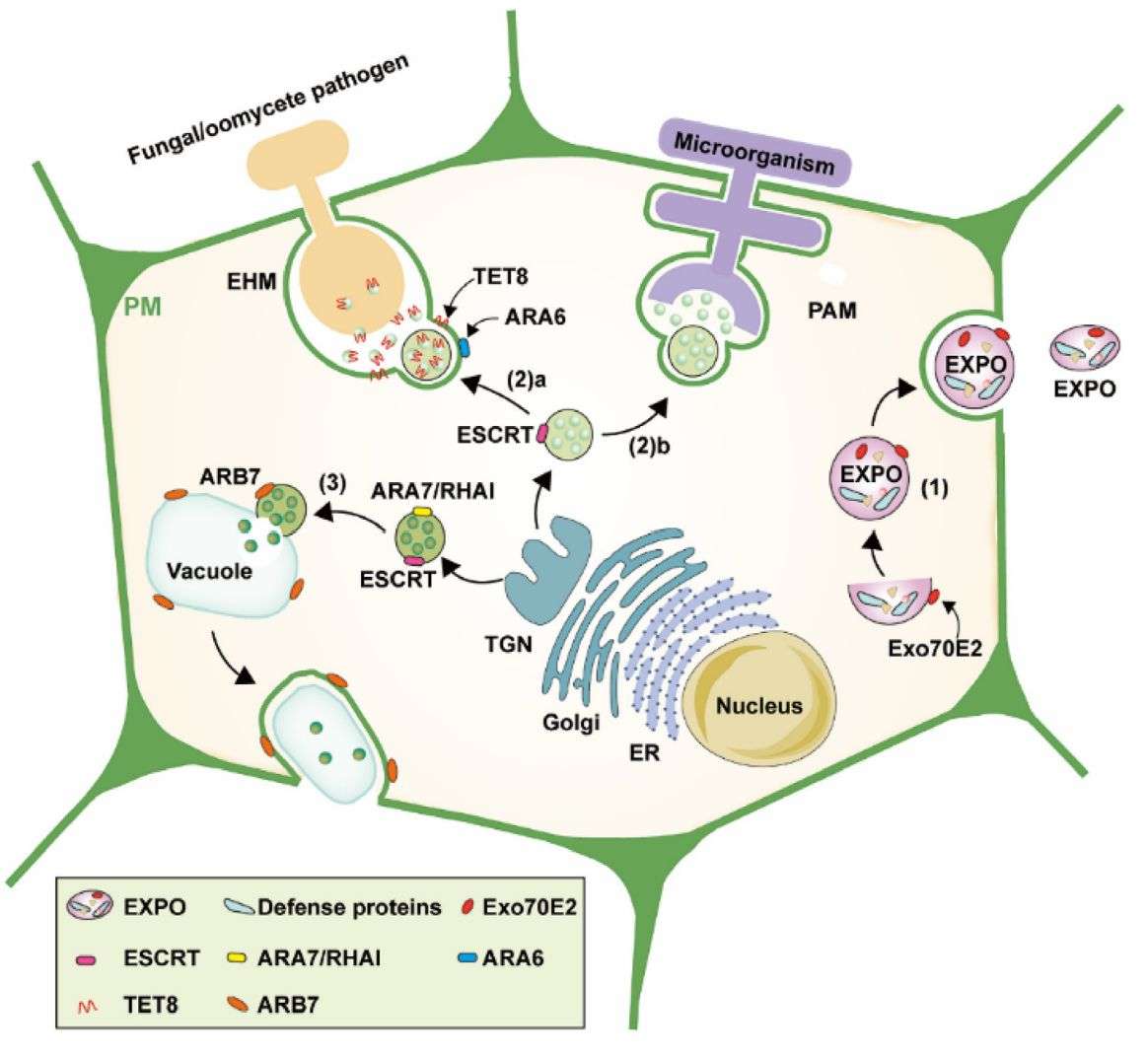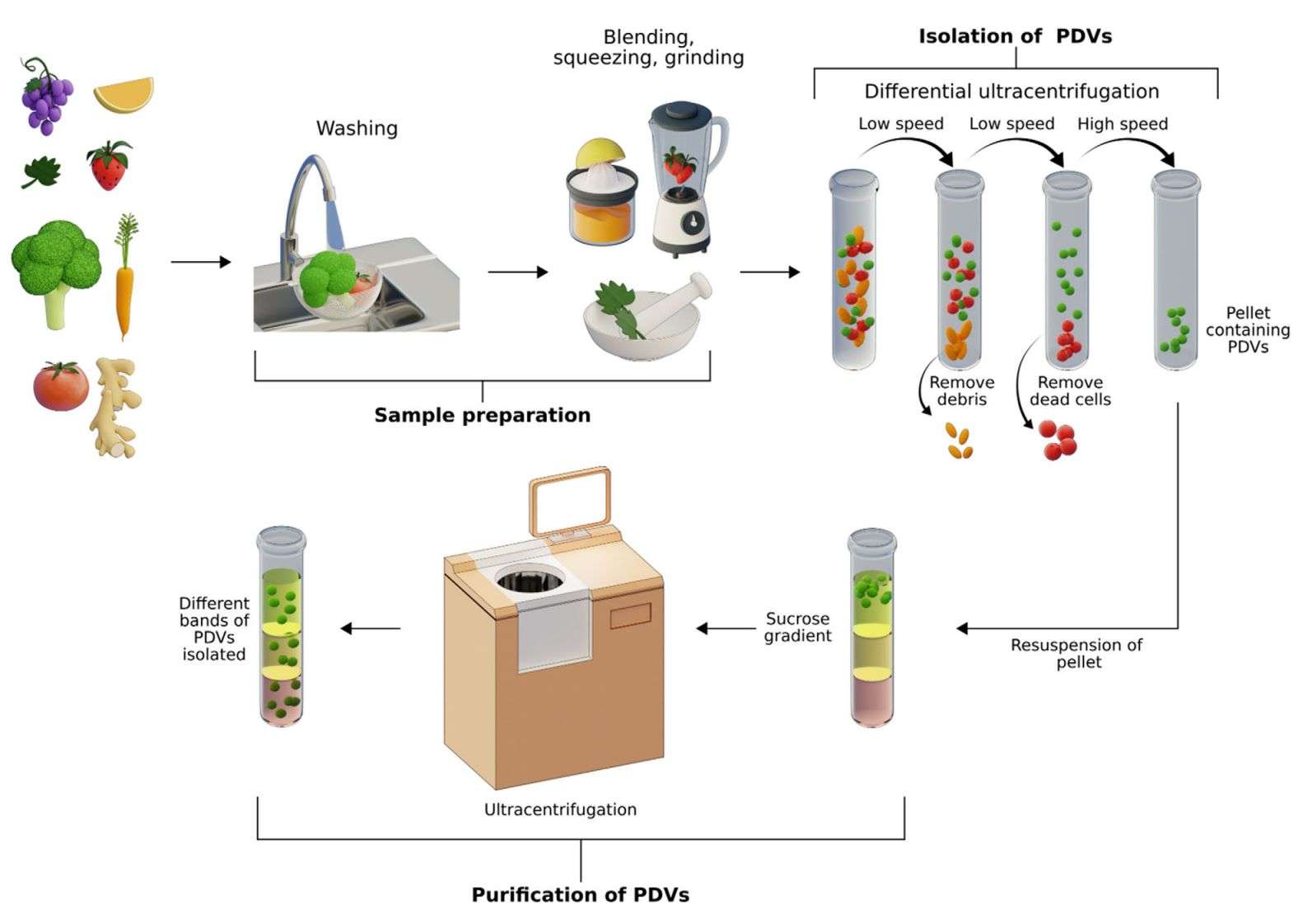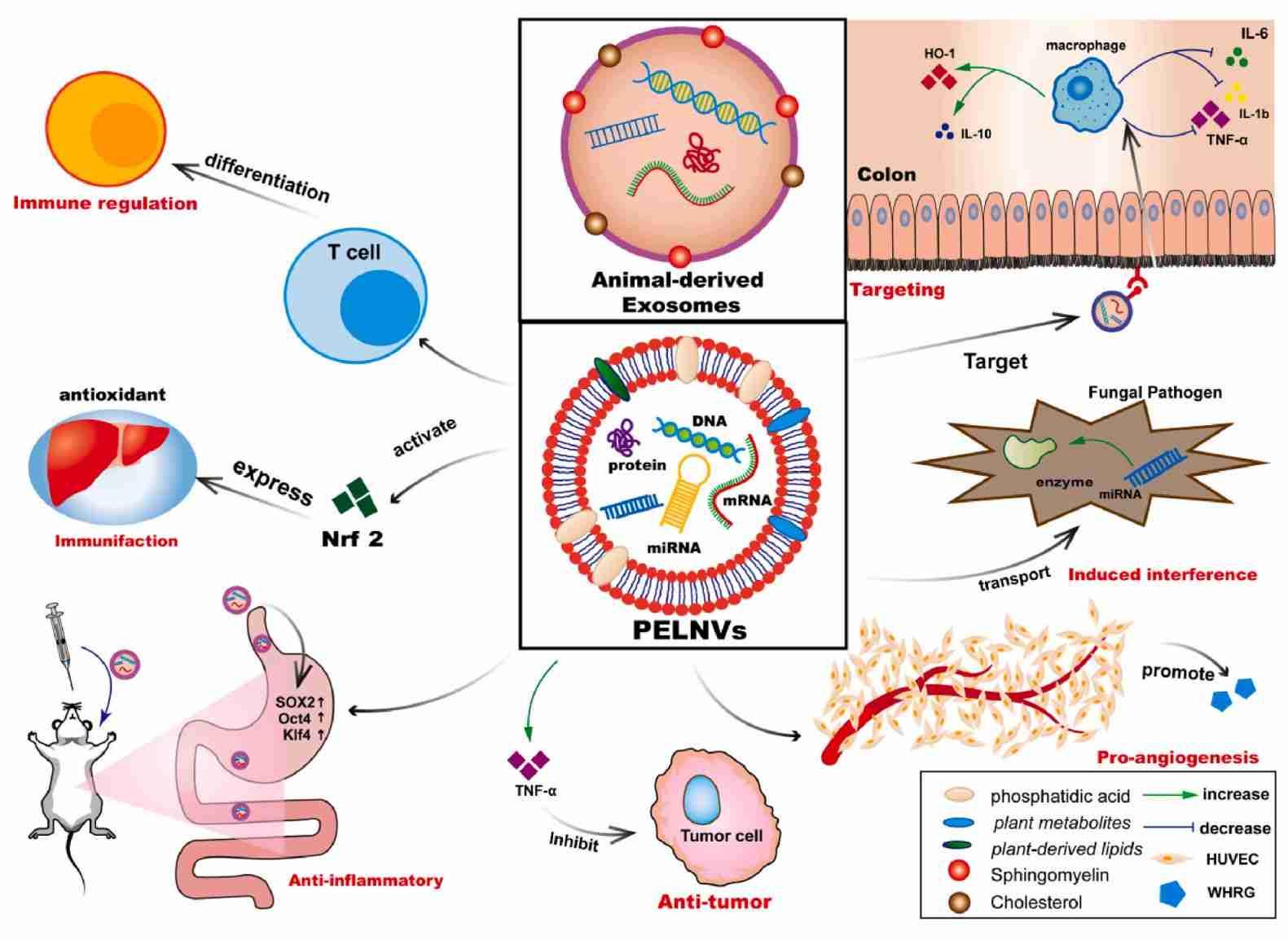Plant-derived Exosomes for Biomedical
Recently, plant-derived exosomes have emerged as a promising area of research due to their potential health benefits and biomedical applications. These exosomes are produced from fruits, flowers, and vegetables and contain a variety of bioactive molecules including nucleic acids, proteins, and lipids. As an alternative to cell-free therapies, plant-derived exosomes have pharmacological activities that affect cellular processes, exerting anti-inflammatory, antioxidant, and anticancer activities that contribute to treating diseases and improving human health.
Composition of Plant-derived Exosomes
Plant-derived exosomes are similar to mammalian origin and contain biologically active components such as proteins, lipids, mRNAs, and microRNAs. These exosomes consist of cytoplasmic and membrane proteins such as heat shock proteins (CD9 and CD63), transmembrane proteins (actin, protein hydrolysis proteins, and channel proteins), and defense proteins. Studies have demonstrated that exosomes in citrus fruits contain a variety of proteins, such as fructose diphosphate for glycolysis, PTL39 and HSP80 for protein folding and transport, as well as lattice protein 3 and PTL3 for cell growth and division.
 Figure 1. Schematic of plant-derived exosomes. (Aixue Li, et al., 2023)
Figure 1. Schematic of plant-derived exosomes. (Aixue Li, et al., 2023)
How to Prepare Plant-derived Exosomes?
The appropriate isolation and purification methods for plant-derived exosomes are usually selected based on the physicochemical properties and the site of origin. The main methods include differential ultracentrifugation(dUC), density gradient centrifugation, and polymer precipitation. The dUC takes advantage of the differences in density and size between exosomes and other components and separates exosomes by varying centrifugal forces. Impurities and cellular debris are removed at low speeds, while vesicles are separated and exosomes are precipitated at high speeds. However, dUC is less efficient in separating viscous tissues, so further purification of exosomes by sucrose gradient centrifugation is required. In addition, microfluidic technology can also be used for the separation of exosomes in plants with fast processing speed and high sensitivity.
 Figure 2. Isolation process of plant-derived exosomes. (Lian MQ, et al., 2022)
Figure 2. Isolation process of plant-derived exosomes. (Lian MQ, et al., 2022)
Advantages of Plant-derived Exosomes for Biomedical Use
- Natural origin, rich in phospholipids;
- Lipid membranes that protect the contents from external substances;
- Natural mechanism of cellular uptake which allows it to cross the blood-brain barrier and the placenta;
- Tolerated and nontoxic by the immune system because it is present in foods ingested by humans;
- Proven scalability and suitability for industrial applications;
- Long-term availability from a wide range of cultivable plants.
 Figure 3. Pharmacological effects of plant-derived exosomes. (Jin Z, et al., 2024)
Figure 3. Pharmacological effects of plant-derived exosomes. (Jin Z, et al., 2024)
Biomedical Applications of Plant-derived Exosomes
- Anti-inflammation
Inflammation often causes systemic reactions such as fever, leukocytosis, and organ lesions, which affect the normal function of the body. It has been found that plant-derived exosomes control inflammation from the transcriptional level of mRNA. For example, turmeric-derived exosomes ameliorate inflammatory symptoms in mice by upregulating the expression of the antioxidant heme oxygenase-1 (HO-1). Furthermore, in terms of inducing transcription, miRNAs in plant-derived exosomes can bind to UTR'3 to repress translation or to promoter regions to induce transcription. This gives miRNAs from plant-derived exosomes the potential to be used as endogenous drugs to alleviate disease symptoms or prevent disease onset from both the transcriptional and translational levels.
- Antioxidant
The antioxidant properties of plant-derived exosomes are attributed to the ability to deliver miRNAs. It is reported that miR-CM1 in mushroom-derived exosomes can target the 3'UTR of Mical2, thereby inhibiting its expression to reduce ROS. In addition, the regulation of oxidative stress by plant-derived exosomes is found to further inhibit apoptosis and enhance cell proliferative activity, which is associated with vitamin C in the exosomes. For example, carrot-derived exosomes effectively inhibited ROS production and oxidative stress-induced apoptosis in H9C2 heart-derived cells, which has great potential for the treatment of diseases caused by ROS production and abnormal apoptosis, including myocardial infarction.
- Anti-tumor
The development of anti-tumor drugs remains a challenge due to tumor resistance and drug side effects. In recent years, plant-derived exosomes have received widespread attention due to their safe source, low side effects, and good anti-tumor efficacy. It has been reported that exosomes from asparagus induce apoptosis of cancer cells by up-regulating the apoptosis-related factor caspase-9 in hepatocellular carcinoma cells. Corn-derived exosomes exert anti-tumor effects by activating macrophages to produce the pro-inflammatory cytokine TNF- α. In addition, surface modifications of plant-derived exosomes have been developed to deliver nucleic acids to specific target cells. For example, plant-derived exosomes containing folic acid on the surface are constructed to promote cellular uptake, resulting in significant genetic alterations and tumor growth inhibition in cancer cells.
Our Services and Products
In recent years, there have been numerous studies on plant-derived exosomes as drugs for treating various diseases, but the understanding of their action mechanisms is still limited. In addition, the stability, quality, and standardization of plant-derived exosomes during extraction is a huge challenge.
Creative Biostructure is a pioneering company dedicated to unlocking the biomedical potential of plant-derived exosomes. Our comprehensive services and state-of-the-art products enable clients to accurately penetrate the frontiers of exosome research. By providing diverse exosome solutions, including exosome isolation, characterization, engineering, in vivo and in vitro functional analyses, and high-purity exosome products, we will facilitate the development of groundbreaking research and innovation in the biomedical field.
| Cat No. | Product Name | Source |
| PNE-VC04 | PNExo™ Exosome-Cucumber | Exosome derived from Cucumber |
| Exo-PDELN04 | HQExo™ Exosome-Potato | Exosome derived from Potato |
| PNE-VB23 | PNExo™ Exosome-Bean Sprout | Exosome derived from Bean Sprout |
| PNE-VB11 | PNExo™ Exosome-Beets | Exosome derived from Beets |
| PNE-VL17 | PNExo™ Exosome-Lettuce | Exosome derived from Lettuce |
| PNE-VB13 | PNExo™ Exosome-Broccoli | Exosome derived from Broccoli |
| PNE-VB14 | PNExo™ Exosome-Brussels Sprout | Exosome derived from Brussels Sprout |
| PNE-FB34 | PNExo™ Exosome-Blueberry | Exosome derived from Blueberry |
| PNE-FC38 | PNExo™ Exosome-Cranberry | Exosome derived from Cranberry |
| PNE-FB42 | PNExo™ Exosome-Banana | Exosome derived from Banana |
| PNE-FD50 | PNExo™ Exosome-Durian | Exosome derived from Durian |
| PNE-FC54 | PNExo™ Exosome-Coconut | Exosome derived from Coconut |
| PNE-FC85 | PNExo™ Exosome-Concord Grape | Exosome derived from Concord Grape |
| PNE-FP93 | PNExo™ Exosome-Prickly Pear | Exosome derived from Prickly Pear |
| PNE-FLD10 | PNExo™ Exosome-Daffodil | Exosome derived from Daffodil |
| PNE-FLC30 | PNExo™ Exosome-Carnation | Exosome derived from Carnation |
| PNE-FLA31 | PNExo™ Exosome-Amaryllis | Exosome derived from Amaryllis |
| PNE-FLC42 | PNExo™ Exosome-Begonia | Exosome derived from Begonia |
| PNE-FLA43 | PNExo™ Exosome-Anemone | Exosome derived from Anemone |
| PNE-FLD46 | PNExo™ Exosome-Dogwood | Exosome derived from Dogwood |
| PNE-FLD51 | PNExo™ Exosome-Daphne | Exosome derived from Daphne |
| PNE-FLF63 | PNExo™ Exosome-Forget-me-not | Exosome derived from Forget-me-not |
| Explore All Exosomes Isolated from Plants | ||
If you are interested in our exosome services and products, please feel free to contact us. We will help you utilize the translational power of plant-derived exosomes to shape the future of biomedical applications.
References
- Aixue Li, et al. Plant-derived nanovesicles: Further exploration of biomedical function and application potential. Acta Pharmaceutica Sinica B. 2023. 13(8): 3300-3320.
- Lian MQ, et al. Plant-derived extracellular vesicles: Recent advancements and current challenges on their use for biomedical applications. J Extracell Vesicles. 2022. 11(12):e12283.
- Jin Z, et al. Plant-derived exosome-like nanovesicles: A novel nanotool for disease therapy. Heliyon. 2024. 10(9): e30630.
- Sarasati A, et al. Plant-Derived Exosome-like Nanoparticles for Biomedical Applications and Regenerative Therapy. Biomedicines. 2023. 11(4): 1053.
- Kai-Jiun Lo, et al. Plant-Derived Extracellular Vesicles: A New Revolutionization of Modern Healthy Diets and Biomedical Applications. Journal of Agricultural and Food Chemistry. 2024. 72(6): 2853-2878.